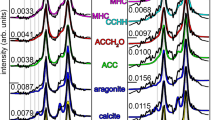Abstract
Biogenic minerals often contain inorganic and organic impurities that are believed to harden and toughen the material. However, because of the complexity of these systems, it is difficult to deconvolute the effect of each of these impurities on the hardness of the material. We have created single-crystal samples with a range of magnesium concentrations and measured their hardness while controlling for orientation. We find that hardness increases linearly with magnesium content and that magnesium impurities could account for ∼20% of the increased hardness in biogenic calcite from the mollusk Atrina rigida when compared with pure geologic calcite.


Similar content being viewed by others
Change history
01 March 2013
An Erratum to this paper has been published: https://doi.org/10.1557/mrc.2012.31
References
M.A. Meyers, P.-Y. Chen, A. Y.-M. Lin, and Y. Seki: Biological materials: structure and mechanical properties. Prog. Mater. Sci. 53, 1 (2008).
Y.R. Ma, S.R. Cohen, L. Addadi, and S. Weiner: Sea urchin tooth design: an “all-calcite” polycrystalline reinforced fiber composite for grinding rocks. Adv. Mater. 20, 1555 (2008).
R.Z. Wang, L. Addadi, and S. Weiner: Design strategies of sea urchin teeth: structure, composition and micromechanical relations to function. Philos. Trans. R. Soc. Lond. B 352, 469 (1997).
M.E. Kunitake, L.M. Mangano, J.M. Peloquin, S.P. Baker, and L.A. Estroff: Evaluation of strengthening mechanisms in calcite single crystals from mollusk shells. Acta Biomater. (2012, submitted).
C. Moureaux, A. Pérez-Huerta, P. Compère, W. Zhu, T. Leloup, M. Cusack, and P. Dubois: Structure, composition and mechanical relations to function in sea urchin spine. J. Struct. Biol. 170, 41 (2010).
A. Perez-Huerta, M. Cusack, and W. Zhu: Assessment of crystallographic influence on material properties of calcite brachiopods. Mineral. Mag. 72, 563 (2008).
A. Pérez-Huerta, M. Cusack, W. Zhu, J. England, and J. Hughes: Material properties of brachiopod shell ultrastructure by nanoindentation. J. R. Soc. Interface 4, 33 (2007).
E. Griesshaber, W.W. Schmahl, R. Neuser, T. Pettke, M. Blum, J. Mutterlose, and U. Brand: Crystallographic texture and microstructure of terebratulide brachiopod shell calcite: an optimized materials design with hierarchical architecture. Am. Mineral. 92, 722 (2007).
J. Aizenberg and G. Hendler: Designing efficient microlens arrays: lessons from Nature. J. Mater. Chem. 14, 2066 (2004).
C. Merkel, J. Deuschle, E. Griesshaber, S. Enders, E. Steinhauser, R. Hochleitner, U. Brand, and W.W. Schmahl: Mechanical properties of modern calcite (Mergerlia truncata) and phosphate-shelled brachiopods (Discradisca stella and Lingula anatina) determined by nanoindentation. J. Struct. Biol. 168, 396 (2009).
L.M. Anovitz and E.J. Essene: Phase equilibria in the system CaCO3-MgCO3-FeCO3. J. Petrol. 28, 389 (1987).
S. Raz, S. Weiner, and L. Addadi: Formation of high-magnesian calcites via an amorphous precursor phase: possible biological implications. Adv. Mater. 12, 38 (2000).
H.Y. Li and L.A. Estroff: Calcite growth in hydrogels: assessing the mechanism of polymer-network incorporation into single crystals. Adv. Mater. 21, 470 (2009).
G. Falini, M. Gazzano, and A. Ripamonti: Magnesium calcite crystallization from water-alcohol mixtures. Chem. Commun. 9, 1037 (1996).
W.C. Oliver and G.M. Pharr: Measurement of hardness and elastic modulus by instrumented indentation: advances in understanding and refinements to methodology. J. Mater. Res. 19, 3 (2004).
P. Elstnerova, M. Friak, H.O. Fabritius, L. Lymperakis, T. Hickel, M. Petrov, S. Nikolov, D. Raabe, A. Ziegler, S. Hild, and J. Neugebauer: Ab initio study of thermodynamic, structural, and elastic properties of Mg-substituted crystalline calcite. Acta Biomater. 6, 4506 (2010).
B. Pokroy, A.N. Fitch, F. Marin, M. Kapon, N. Adir, and E. Zolotoyabko: Anisotropic lattice distortions in biogenic calcite induced by intracrystalline organic molecules. J. Struct. Biol. 155, 96 (2006).
A. Stashans and G. Chamba: A new insight on the role of Mg in calcite. Int. J. Quantum Chem. 111, 2436 (2011).
S.J. Tsipursky and P.R. Buseck: Structure of magnesian calcite from sea urchins. Am. Mineral. 78, 775 (1993).
D.J. Barber, R.J. Reeder, and D.J. Smith: A TEM microstructural study of dolomite with curved faces (saddle dolomite). Contrib. Mineral. Petrol. 91, 82 (1985).
K.J. Davis, P.M. Dove, L.E. Wasylenki, and J.J. De Yoreo: Morphological consequences of differential Mg2+ incorporation at structurally distinct steps on calcite. Am. Mineral. 89, 714 (2004).
J. Paquette and R.J. Reeder: Relationship between surface structure, growth mechanism, and trace element incorporation in calcite. Geochim. Cosmochim. Acta 59, 735 (1995).
T.H. Courtney: Mechanical Behavior of Materials (McGraw-Hill, New York, 1990).
A.G. Evans and T.G. Langdon: Structural ceramics. Prog. Mater. Sci. 21, 171 (1976).
X. Long, M.J. Nasse, Y. Ma, and L. Qi: From synthetic to biogenic Mg-containing calcites: a comparative study using FTIR microspectroscopy. Phys. Chem. Chem. Phys. 14, 2255 (2012).
X. Long, Y. Ma, and L. Qi: In vitro synthesis of high Mg calcite under ambient conditions and its implication for biomineralization process. Cryst. Growth Des. 11, 2866 (2011).
Acknowledgments
We acknowledge support from NSF (DMR 0845212), the J.D. Watson Investigator Program (NYSTAR Contract No. C050017), the GI Bill (Chapter 33), and Hysitron Inc. We also acknowledge the Cornell Center for Materials Research (CCMR), a Materials Research Science and Engineering Center of the National Science Foundation (DMR 1120296), for both research support and use of the Electron Microscopy facility. We would also like to thank John Hunt for WDS measurements and Benjamin Shulman for help with sample preparation. Supporting Information is available online from MRS Communications or from the authors.
Author information
Authors and Affiliations
Corresponding author
Supporting Information for
Supplementary materials
Supplementary materials
For supplementary material for this article, please visit http://dx.doi.org/10.1557/mrc.2012.20
Rights and permissions
About this article
Cite this article
Kunitake, M.E., Baker, S.P. & Estroff, L.A. The effect of magnesium substitution on the hardness of synthetic and biogenic calcite. MRS Communications 2, 113–116 (2012). https://doi.org/10.1557/mrc.2012.20
Received:
Accepted:
Published:
Issue Date:
DOI: https://doi.org/10.1557/mrc.2012.20




